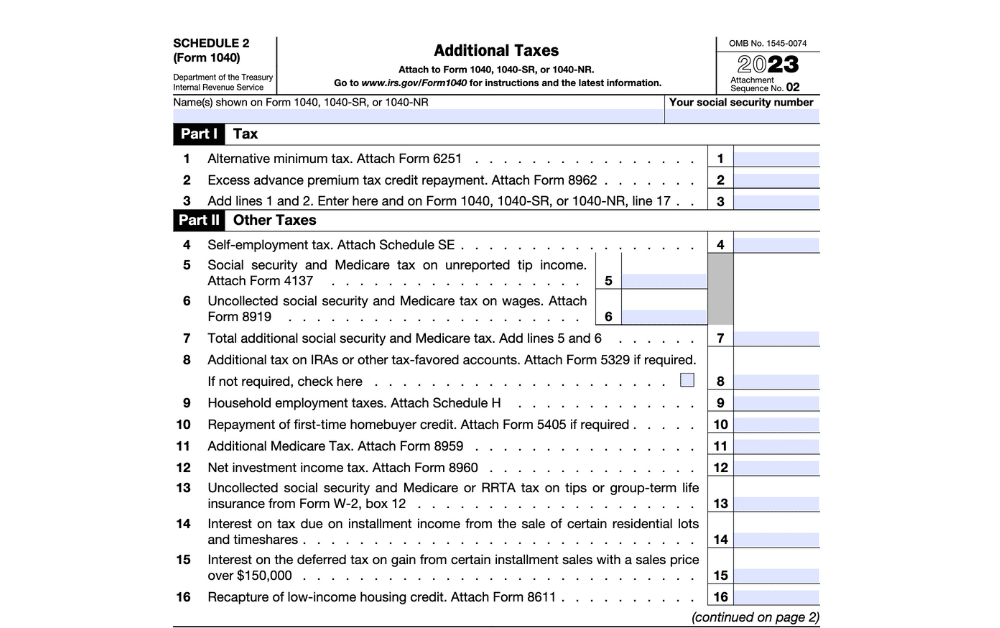What Is IRS Form 1040 Schedule 2? (And How to File)

Understanding whether you need to complete Schedule 2 is important in ensuring your taxes are filed correctly. Here’s what you should know.
Key Takeaways
- IRS Form 1040 Schedule 2 is used to report certain non-traditional taxes not covered by the standard Form 1040.
- You may need to file Schedule 2 if:
-
- You earn a high income and owe alternative minimum tax (AMT), Net Investment Income Tax (NIIT), or the additional Medicare tax
- You need to repay health insurance tax credits
- You owe additional taxes, such as the self-employment tax
What Is IRS Form 1040 Schedule 2?
IRS Form 1040 Schedule 2 is for taxpayers who have additional taxes due that aren’t covered on the standard IRS Form 1040. The IRS consolidated the previously available forms (1040, 1040A, and 1040EZ) into a single, streamlined Form 1040 to simplify tax filing.
Accompanying this change, they added several new schedules to collect detailed financial information without overcrowding the main form. One of the most important is Schedule 2.
Who Has to File Schedule 2?
Generally, you’ll need to file this schedule if you fall into one of the following categories:
- High-income taxpayers who owe an alternative minimum tax (AMT), the flat 3.8% Net Investment Income Tax, or the flat 0.9% additional Medicare tax
- Taxpayers who need to repay a portion of a tax credit for the health insurance marketplace
- Taxpayers who owe additional taxes: This includes a range of situations, such as:
- Self-employed individuals who owe Social Security and Medicare taxes
- Taxpayers who received income not subject to Social Security or Medicare withholdings (e.g., unreported tips)
- Individuals with certain IRA distributions or who made excess contributions to retirement or health savings accounts

Parts of IRS Schedule 2
Schedule 2 is divided into two parts:
- Part I: Tax
- Part II: Other Taxes
Let’s take a look at each.
Part I: Tax
You will use this section to notify the IRS on which tax or taxes you are reporting on this form. The options are:
- Alternative Minimum Tax (AMT): If you are a high-income earner, the AMT may apply to you. This line requires you to input the AMT amount from Form 6251. AMT tax normally applies when you have a high income, but you are subject to a very low tax rate for whatever reason.
- Repayment of Advance Premium Tax Credit: If you received an advance on your health insurance premium tax credit, this line is where you report any necessary repayments. Complete and attach Form 8962 to determine the amount that should be entered here, if any.
- Total Additional Income Tax Owed: Sum the above amounts and record it on line 3. This total should also be reported on your Form 1040 (or the variant you’re filing) on line 17.
Part II – Other Taxes
Part II of Schedule 2 includes other miscellaneous taxes you may need to report to the IRS. This includes:
- Self-Employment Tax: For self-employed entrepreneurs and freelancers, this section is where you detail the Social Security and Medicare taxes due, calculated with Schedule SE.
- Unwithheld Social Security and Medicare Taxes: If you’ve received income without the proper tax withholdings—for example, from certain types of employment or tips not reported by an employer—this is where that information goes. You’ll need to attach Form 4137 for unreported tips or Form 8919 if your employer didn’t withhold these taxes.
- Retirement Plans: Distributions from IRAs, 401(k)s, and similar accounts that are subject to additional taxes are reported here. This includes early withdrawals and excess contributions. Use Form 5329 to help determine if these taxes apply.
- Health Savings Accounts (HSAs) and Archer MSAs: If you have an HSA or medical savings account (MSA), and you took distributions not used for qualified medical expenses, those are taxable and may incur additional taxes.
- Coverdell Education Savings Account (ESA): Distributions from ESAs not used for educational expenses can also lead to additional taxes.
- 529 Plans: Similar to ESAs, non-qualified distributions from 529 college savings plans may be taxable.
- Household Employment Taxes: If you employ someone in your home and pay them more than a certain threshold, you’re responsible for Social Security, Medicare, and unemployment taxes, as well as federal income tax withholding for your employee.
- First-time homebuyer credit repayment: If you claimed the first-time homebuyer credit in previous years and are required to repay it, this repayment is reported in this section.
- PFICs – and additional tax owed resulting from owning investments in Passive Foreign Investment Companies is reported on Schedule 2. Form 8621 will need to attach form 8621 to your return.
- Any other taxes: – include towards the bottom of Schedule 2 any other taxes you may need to report and pay, such as the excise tax on foreign life insurance policies.
As you navigate through the intricacies of the Schedule 2 form, it’s crucial to note that the 965 tax form, a key component previously relevant to this form, is being phased out.
Dreading the last minute scramble pulling together your tax documents? Despair no more! This simple checklist lists the documents you need to have on hand when preparing to file.

How to File Schedule 2
Submitting IRS Form 1040, Schedule 2, will be part of the process of filing your annual tax return. Here’s how you do it:
1. Complete Form 1040 Schedule 2
First, ensure that you accurately complete Schedule 2, which is used to report additional taxes not included directly on Form 1040. Make sure all relevant sections are filled out based on your financial situation, such as the alternative minimum tax (AMT), taxes on unearned income, self-employment tax, and others, as applicable.
2. Attach Schedule 2 to Form 1040
Once Schedule 2 is completed, it should be attached to your Form 1040 along with any other necessary schedules and forms. Schedule 2 is designed to complement your main tax return form by providing additional details required for your tax assessment.
3. Submit Your Tax Return
Once you’ve completed Schedule 2 and attached it to your tax return, file them together. You can do this by e-filing or mailing a paper return.
- Electronic Filing (E-File): The IRS encourages taxpayers to file their returns electronically for faster processing. When you e-file your tax return through IRS-approved software, it will prompt you to include all necessary information and schedules, including Schedule 2. The software will automatically attach and submit all forms together to the IRS.
- Paper Filing: If you choose to file a paper return, ensure that all forms, including Schedule 2, are correctly filled out and signed. Mail your complete tax return package, including Form 1040 and Schedule 2, to the appropriate IRS address for your state. This address can be found in the instructions for Form 1040.
Always keep a copy of your tax return and all schedules, including Schedule 2, for at least six years. This will be useful for future reference — especially if the IRS has any questions about your return.
Get Expert Help When Filing Form 1040 Schedule 2
Don’t let confusion or uncertainty about Schedule 2 delay your tax filing. Contact Greenback Expat Tax Services for professional, straightforward tax assistance — so you can focus on what matters most.
Let us take the headaches out of your tax season.



